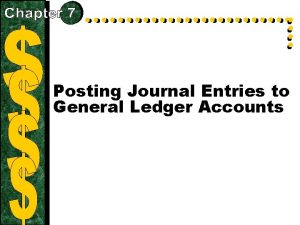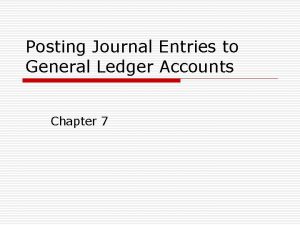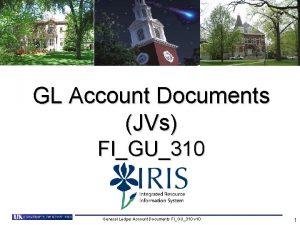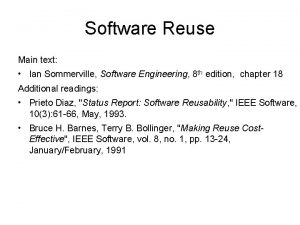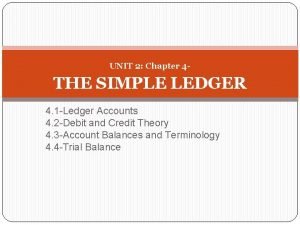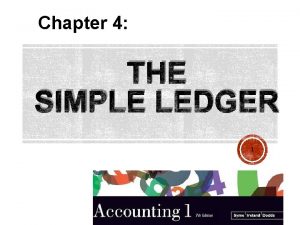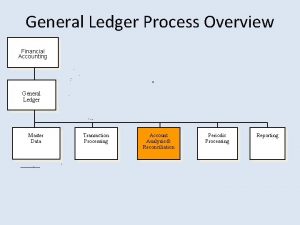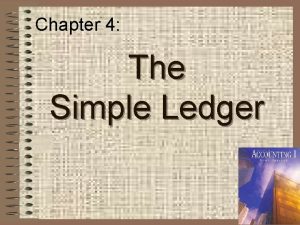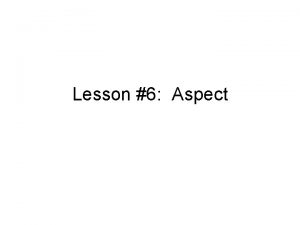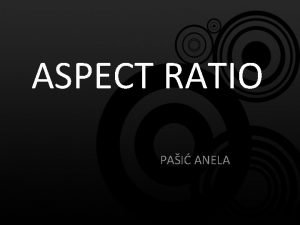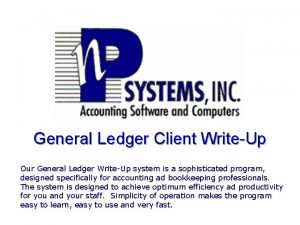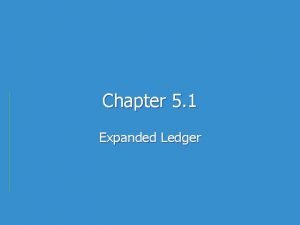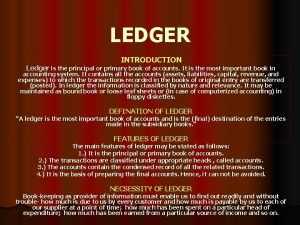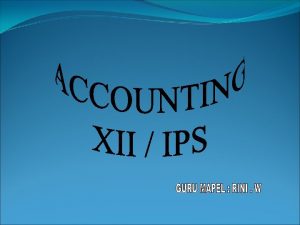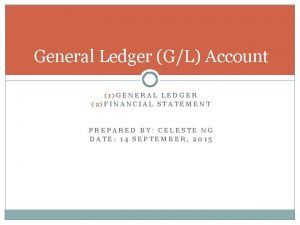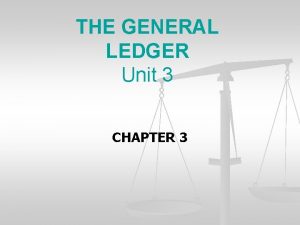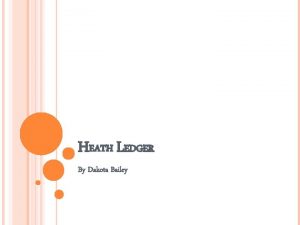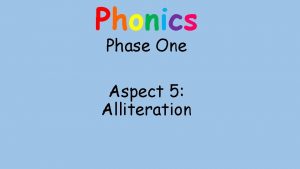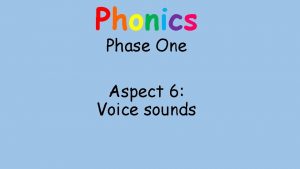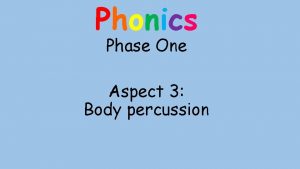The Simple Ledger One Aspect of the Accounting























- Slides: 23

The Simple Ledger One Aspect of the Accounting Cycle: (Debit & Credit Theory – T-Accounts Tool) 1 Accounting 1, 7 th edition 4

Section Number 4. 1 Ledger Accounts 4. 2 Debit and Credit Theory 4. 3 Accounting Balances & Terminology Trial Balance 4. 4 4. 5 2 Title Accounting 1, 7 th edition A Spreadsheet for Ledger Accounts (w/ Trial Balances)

Section 4. 1 Ledger Accounts Account – Any item that appears on a balance sheet An Account represents any aspect/element of a business that can be affected by a business transaction. Ledger – A book that lists all of a Business’ Accounts. A ledger is used to record all changes made to a particular business account. 3 Accounting 1, 7 th edition

Section 4. 1 Ledger Accounts A Balance Sheet is used to set up a Ledger w/Accounts and provide the Beginning/Opening Balances. Figure 4. 2: Pacific Trucking Balance Sheet 4 Accounting 1, 7 th edition

Section 4. 1 Ledger Accounts There are many types of accounts used by accountants. All accounts must follow the Accounting Equation The following are T-Accounts. Figure 4. 3: Pacific Trucking Ledger with Opening Balances 5 Accounting 1, 7 th edition

6 Section 4. 2 Debit and Credit Theory All T-Accounts have a Left-Side and a Right-Side. The word Debit is associated with the Left-Side. Debit refers to Have and Own (what the business has). Debit (Dr) Credit (Cr) The word Credit is associated with the Right-Side. Credit refers to OWE (who really owns the assets). Accounting 1, 7 th edition

7 Section 4. 2 Debit and Credit Theory Assets, Liabilities, and Owner’s Equity accounts have their own Debit and Credit rules. Asset accounts are on the left of the balance sheet, so their beginning value is a debit, and a debit increases their account balance. Liability and Owner’s Equity accounts are on the right of the balance sheet, so their beginning value is a credit, and a credit increases their account balance. Accounting 1, 7 th edition

8 Section 4. 2 Debit and Credit Theory Remember, Assets behave opposite from Liabilities and Owner’s Equity because they are on different sides of the Balance Sheet. T-Account Transactional Analysis Sheet: Double Entry Accounting Check – Verify All is Balanced Accounting 1, 7 th edition

9 Section 4. 2 Debit and Credit Theory Let’s Apply the Rules of Debit & Credit by analysing 7 transactions of the Pacific Trucking Company. Transaction 1: The company purchases $200 worth of supplies from Packham Products, to be paid for later. Transaction 2: The company pays $500 to Dini Bros. in partial payment of the amount owed to them. Transaction 3: The company receives $200 cash from R. Van Loon in partial payment of her debt. Transaction 4: A delivery service is provided for a customer at a price of $400. The customer pays cash at the time the service is completed. Accounting 1, 7 th edition

1 0 Section 4. 2 Debit and Credit Theory Transaction 5: A used truck costing $8000 is purchased from Dini Bros. A cash down payment of $2500 is made at the time of the purchase and the balance is to be paid at a later date. Transaction 6: A delivery service is completed for R. Van Loon at a price of $350. Van Loon does not pay for the service at the time it is provided, but agrees to pay within 30 days. Transaction 7: One of the lifting machines (part of Equipment) breaks down. The company spends $650 cash to have the machine repaired. Accounting 1, 7 th edition

Section 4. 2 Debit and Credit Theory Figure 4. 5: Pacific Trucking Ledger with Seven Transactions 11 Accounting 1, 7 th edition

Section 4. 3 Account Balances & Terminology Everything is Based on the Accounting Equation Everything in Accounting must Balance The Balance Sheet provides the Accounts and Beginning/Opening Balances Each Transaction affects at Least Two Accounts The Total of all Debits must Equal the Total of all Credits 12 Accounting 1, 7 th edition

Section 4. 3 Account Balances & Terminology To Settle (Balance) each T-Account you must: 1) Draw a line after the last transaction 2) Total the Debit (Left) and Credit (Right) side separately 3) Write the subtotals in each column under the line using small (Pin-Totals) print 4) Subtract the smaller from the larger then circle and write the total below the subtotal 13 Accounting 1, 7 th edition

Section 4. 3 Account Balances & Terminology Account Balances Example : Figure 4. 9: Completed Ledger for Pacific Trucking 14 Accounting 1, 7 th edition

Section 4. 3 Account Balances & Terminology You will be expected to be able to Interpret the Balance of an Account 1) To understand what is a Normal (Expected) Account Balance 2) To know when an Account is Exceptional (Irregular: Breaks the Rules) Note: Know the “Buying & Selling on Account” Examples on pg. 109 15 Accounting 1, 7 th edition

Section 4. 3 Account Balances & Terminology 1) Normal (Expected) Account Balance It is expected that an Asset will have a balance on the left-hand side (Debit) And a Liability or Owners Equity will have a balance on the right-hand side (credit) 16 Accounting 1, 7 th edition

Section 4. 3 Account Balances & Terminology 2) Exceptional Account Balance Just because the total is on the wrong side does not mean something is wrong, perhaps there is reason for it. In this case, the business returned equipment to it suppliers and now we have a “temporary” in store credit. 17 Accounting 1, 7 th edition In this case, there was not enough money in the bank account to pay for all the bills. Overdraft protection “temporarily” covered this expense.

Section 4. 4 Trial Balance Testing the Books – To check the accuracy of the ledger (do often to avoid nightmares) Trial Balance – A listing of the account balances in a ledger (Total Debits = Total Credits) In Balance / Out of Balance – The books are good or bad. 18 Accounting 1, 7 th edition

Section 4. 4 Trial Balance Example: Out of Balance? See steps 1 -4 on pg. 114 19 Accounting 1, 7 th edition

Section 4. 5 Spreadsheet for Ledger Accounts (w/Trial Balances) Use the ch 4 anna. xls file Transactions (Source Docs) go in the Equation Analysis Sheet. It needs fixing, some formulas are wrong 20 Accounting 1, 7 th edition

Section 4. 5 Spreadsheet for Ledger Accounts (w/Trial Balances) Need to Add/Fix Formulas in the Ledger Use Cell Referencing, to update the accounts Reference the Eq. Analysis Sheet 21 Accounting 1, 7 th edition

Section 4. 5 Spreadsheet for Ledger Accounts (w/Trial Balances) Prepare a Trial Balance, by using Cell Referencing. Reference T-Accounts 22 Accounting 1, 7 th edition

Section 4. 5 Spreadsheet for Ledger Accounts (w/Trial Balances) Prepare a Balance Sheet by using Cell Referencing, update the In-Balance accounts. 23 Accounting 1, 7 th edition
 La structure du texte descriptif
La structure du texte descriptif The fifth step in the accounting cycle is
The fifth step in the accounting cycle is Problem 7-3 analyzing a source document
Problem 7-3 analyzing a source document General ledger accounting training
General ledger accounting training what is a general ledger accounting document
what is a general ledger accounting document One beneficial aspect of grieving is that it
One beneficial aspect of grieving is that it Ian sommerville software engineering
Ian sommerville software engineering Accounting transaction sheet
Accounting transaction sheet The simple ledger chapter 4
The simple ledger chapter 4 One empire one god one emperor
One empire one god one emperor One one one little puppy run
One one one little puppy run One king one law one faith
One king one law one faith One empire one god one emperor
One empire one god one emperor One team one plan one goal
One team one plan one goal See one do one teach one
See one do one teach one One price policy
One price policy One face one voice one habit and two persons
One face one voice one habit and two persons Studiendekanat uni bonn
Studiendekanat uni bonn Asean tourism strategic plan
Asean tourism strategic plan Asean one vision one identity one community
Asean one vision one identity one community Tennisone
Tennisone Past simple for future
Past simple for future Present simple past simple future simple
Present simple past simple future simple Past continuous present simple
Past continuous present simple

